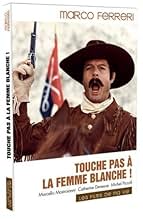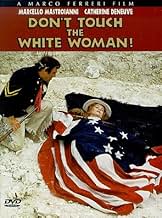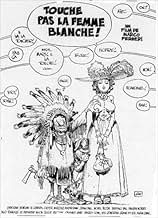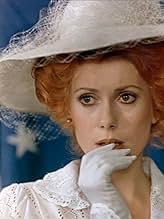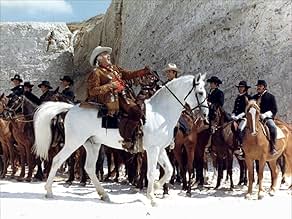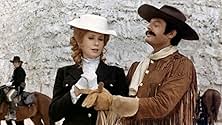Füge eine Handlung in deiner Sprache hinzuA highly stylized surreal farce about the events leading up to Custer's Last Stand anachronistically reenacted in an urban renewal area in modern Paris.A highly stylized surreal farce about the events leading up to Custer's Last Stand anachronistically reenacted in an urban renewal area in modern Paris.A highly stylized surreal farce about the events leading up to Custer's Last Stand anachronistically reenacted in an urban renewal area in modern Paris.
- Regie
- Drehbuch
- Hauptbesetzung
- Rayon de Lune
- (as Franca Bettoja)
- Tom
- (as Franco Fabrizzi)
- Un homme du pouvoir
- (as Vedres et Boutang)
- Un homme du pouvoir
- (as Vedres et Boutang)
Empfohlene Bewertungen
I read about how Marco Ferreri played a major role in the changing Italian cinema of the '60s and '70s. Certainly this film shows that. Specifically, as the United States had been taking a different look at its own history - our own glasnost and perestroika, you might say - Europe was also challenging the American cultural myth (no surprise there). I definitely recommend the movie. Also starring Catherine Deneuve and Ugo Tognazzi.
Just another ordinary version of the battle between settlers and Indians at Little Big Horn? Far from it! The ever wayward filmmaker Marco Ferreri chose to film the battle of Little Big Horn at the place where Les Halles - the Parisian vegetable market - was taken down in 1974. In fact, it was actually taken down during the filming of this movie. The demolishers were probably rubbing their eyes in astonishment. Catherine Deneuve, right here, in this mess?
I enjoyed the movie immensely. All the actors wear the same deadpan expressions as if they really are blind to the fact that they are acting out a traditional western story in a modern setting. Unlike in Les Visiteurs, no jokes about the confrontation with modernity. The characters just do not seem to see it, as if they live in another dimension. It creates many brilliant moments, such as when a cannon is fired and a building collapses. Or if Custer points to a Coca-Cola advertisement and says: "My wife."
Made in the early 1970s, this surreal black comedy is usually interpreted as a scathing commentary on America's involvement in Vietnam, but I didn't see it that way. There is nothing in the film which significantly corresponds to the Vietnam conflict, and the few American symbols which show up are so awkwardly out of place and the characters exaggerated in such a ludicrous manner that it had the effect of constantly reminding me that this wasn't really about Americans. I can't claim to know how the European audience for which it was intended would have viewed it, but I saw it as a satirical look at European racism and colonialism (which, of course, would ultimately include both the genocide of Native Americans and the conflict in Vietnam) and a left-wing allegory of capitalism in which the Native Americans represent the oppressed working classes.
As a social/political satire, it achieves it's greatest success in depicting an absolute and brutal racism without being didactic or calling unnecessary attention to it. The most interesting character is Custer's Indian scout. Moving freely among both European and Native American societies, he is detested by both groups and detests both of them in return. The title of the film comes from Custer's constant reminders of the many things which the scout, being an Indian, is not allowed to do. When asked by another Native American why he hates Custer so much, the scout replies "because he treats me like... an Indian". The pause in delivering the line and the comic reaction of both characters afterward is handled exceptionally well.
All in all, the film's success as a left-wing critique of capitalism/colonialism is limited because so many of its clever subtleties get lost in the comedic noise. As a satire on American imperialism it fares much more poorly, coming dangerously close to being little more than a partisan screed. It does, however, achieve moderate success at being an entertaining absurdist farce with excellent comedic performances by the lead actors.
Wusstest du schon
- Zitate
The Mad Indian: It's your fauly, Sitting Bull. You sign peace treaties, and they wipe their asses with ourtreaties. They wipe their asses with them!
Sitting Bull: This is the soldier's fury. The wise President Nixon ignores all this, I hope.
The Mad Indian: They devastated our fields. Yes, our fields! They cut down our forests. Yes, our forests! They exterminated our game. Yes, our game! They poison us every day with their alcohol and their flour full of strychnine. But don't listen to me. I'm a madman! We are condemned to die on reservations. They slaughter us as soon as they have a chance, but their President doesn't know anything about it. But don't listen to me. I'm a madman. The President doesn't know anything about it.
- VerbindungenEdited into Marcello, una vita dolce (2006)
- SoundtracksGary Owen
(uncredited)
Played by military band and as motif throughout film
Top-Auswahl
- How long is Don't Touch the White Woman!?Powered by Alexa
Details
- Erscheinungsdatum
- Herkunftsländer
- Offizieller Standort
- Sprache
- Auch bekannt als
- Don't Touch the White Woman!
- Drehorte
- Fontaine des Innocents, Paris, Frankreich(Custer and Marie-Hélène walk near and the ballad sung by a soldier is first heard)
- Produktionsfirmen
- Weitere beteiligte Unternehmen bei IMDbPro anzeigen
- Laufzeit1 Stunde 48 Minuten
- Sound-Mix
- Seitenverhältnis
- 1.66 : 1
Zu dieser Seite beitragen


